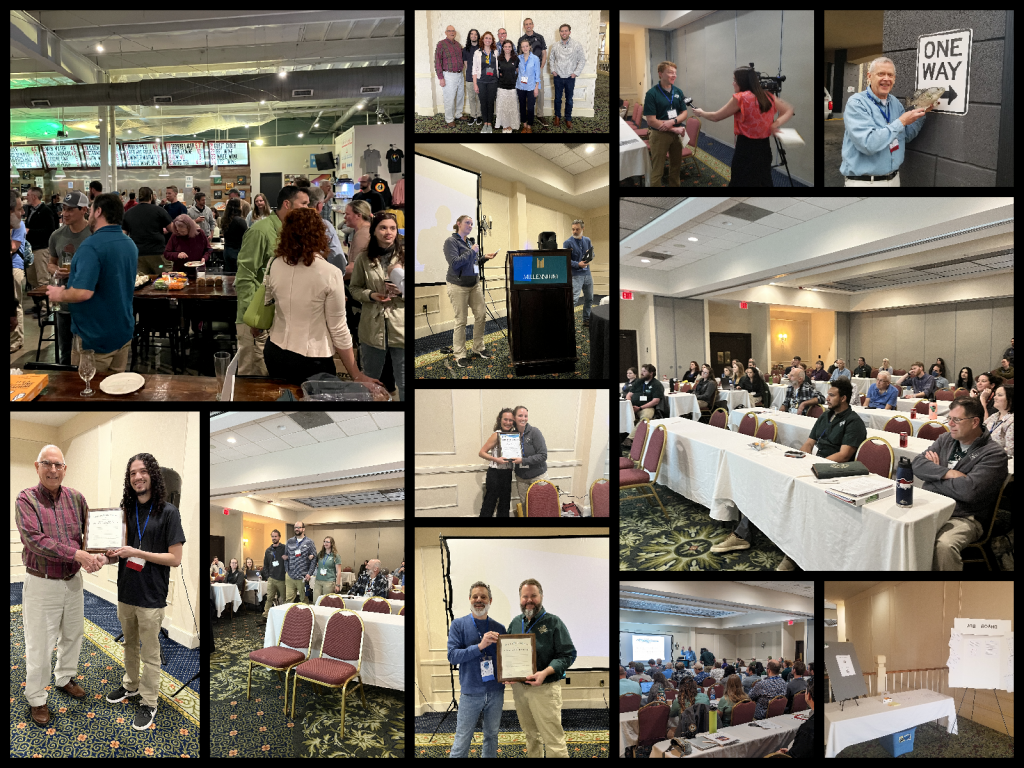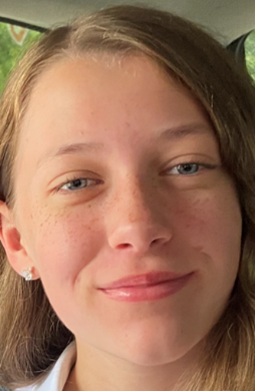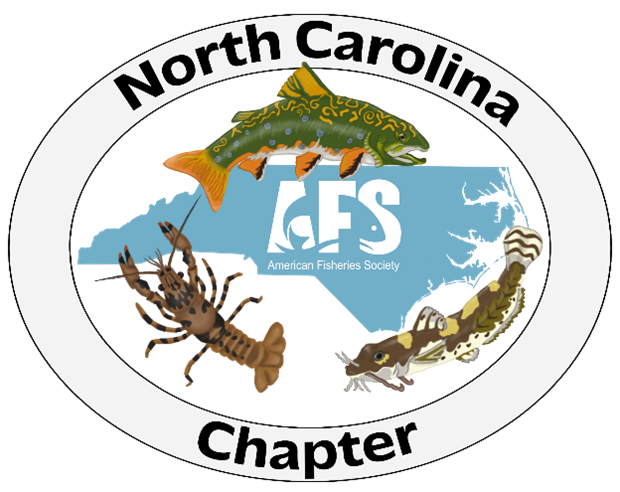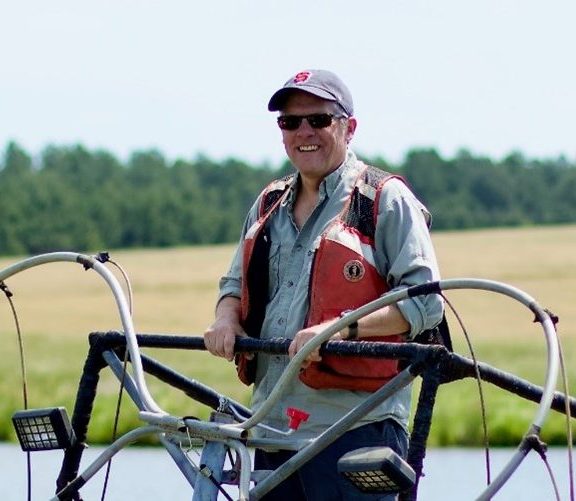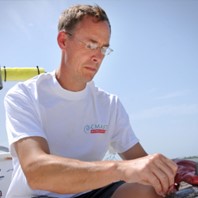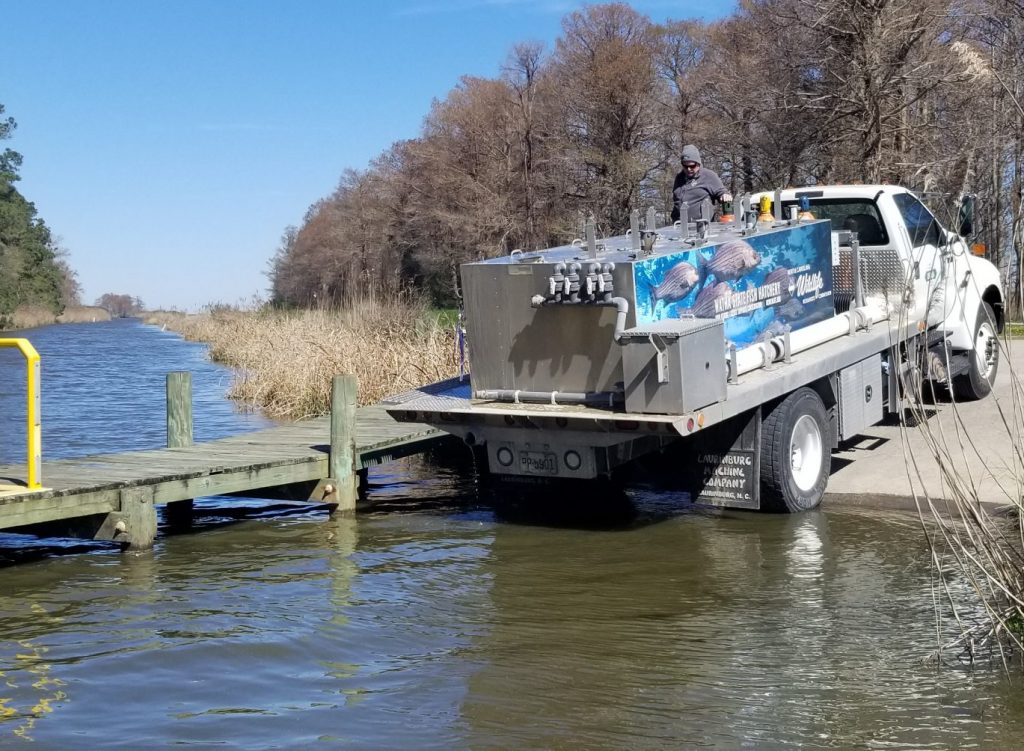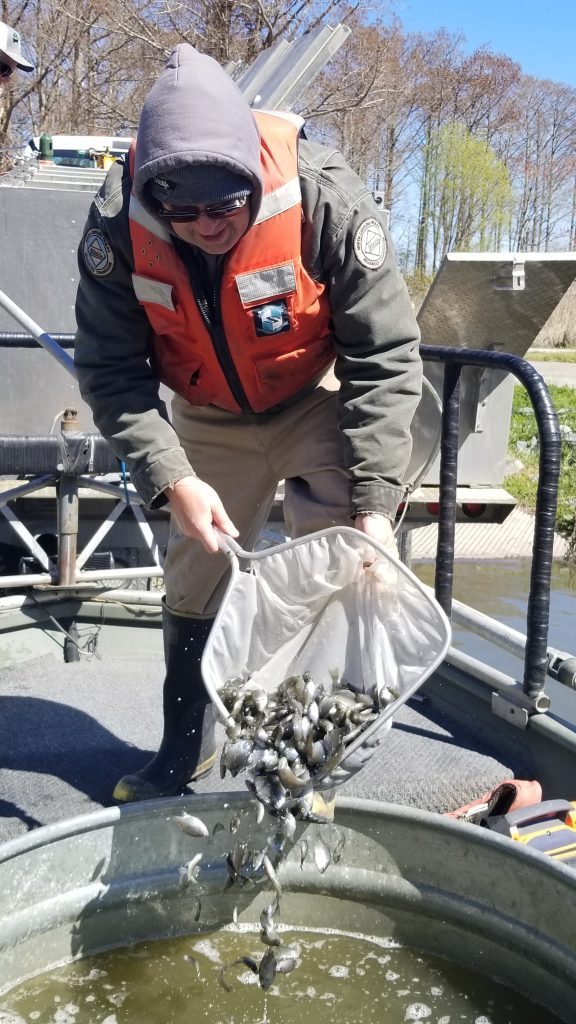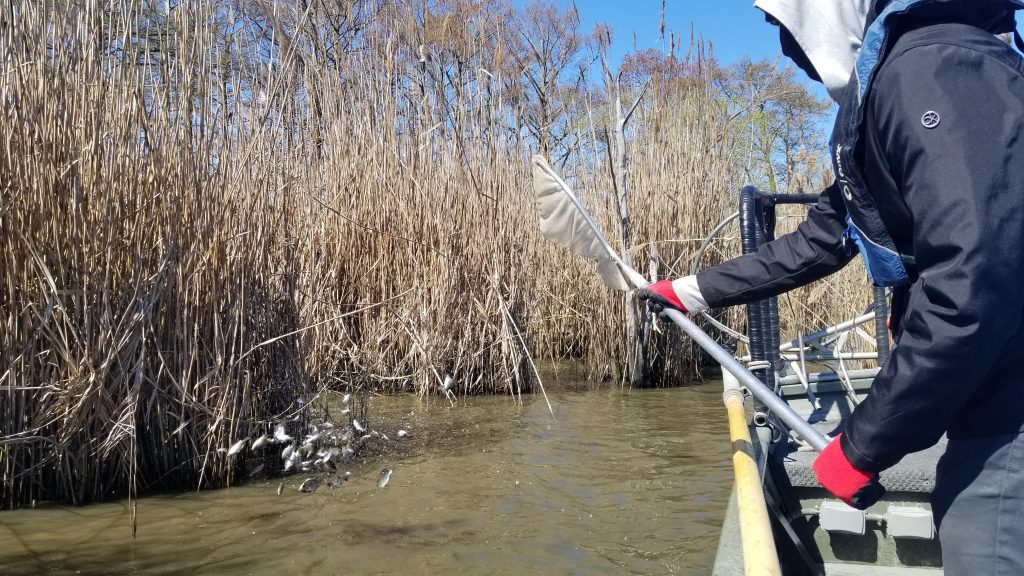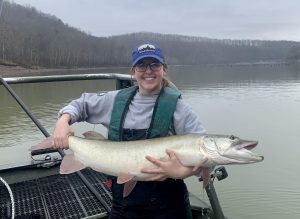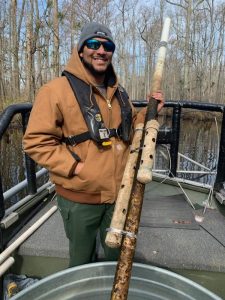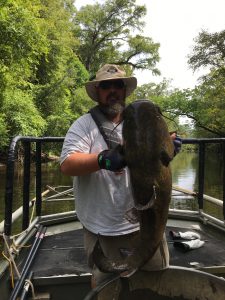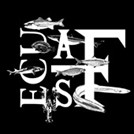Spring 2023 Newsletter

Quick Content Links
- President’s Message
- Treasurer’s Report
- The 2023 NCAFS Meeting in Pictures
- A Sign of the Times–New NCAFS Logo
- Chapter Members Named as Fellows to American Fisheries Society
- Integrated Pest Management Program at Lake Mattamuskeet
- Spotlight on Students and Young Professionals
- Updates from the East Carolina University Student Subunit
- Good Work! – Recent Publications by NCAFS Members
- Stories of Interest
- Call to Action!
- Valuable Links
President’s Message
We had a great meeting in Durham, NC in February where we welcomed Luke Etchison as the new President-Elect! It was a busy meeting with 35 presentations, 4 student posters, an amazing communications workshop taught by Madeline David, and our very first breakfast seminar, “Bagels with Bryn”. We experimented with a different schedule format and welcome any feedback. I am so appreciative for the opportunity to share our ideas and get to know all our members at these meetings. Thank you to those who attended and thank you, especially, to our ExCom members and everyone else who helped the meeting run so smoothly.
In case you missed it, the membership voted to approve two large research grants for two deserving projects and partners. This is the first time in a long time we have had the chance to use the money we’ve saved and hopefully it won’t be our last! We awarded $8,000 to fund a Curation of Ichthyology Collection Internship with the NC Museum of Natural Sciences and we awarded $4,000 to Andy Wood for new equipment to aid in the preservation and conservation of the Magnificent Ramshorn snail. Congratulations to our recipients and we look forward to hearing more about the projects as they progress!
We also began our annual funding of the Hutton Scholar Program. For those of you who have been mentors in the past, you know how rewarding this program is for both mentors and students. This year alone there were 533 applicants across the country and 18 applicants from NC. These applicants cannot be accepted even when they are the best if there are no available mentors in NC. With that, I encourage everyone to consider applying to be a mentor and to learn more about the program!
Lastly, NCAFS is hosting SDAFS 2025 in Asheville, NC! Thank you to everyone who has already volunteered to help with planning. If you are interested in volunteering, please fill out our very quick survey to learn more about the different committees and to sign up.
Of course, we can’t forget that we have a new logo! Andrea Leslie lead this effort, read on to hear more about how it was made and the story behind the new logo.
Wishing everyone a happy and safe spring season!!
Kelsey
Submitted by Kelsey Roberts, NCAFS President
Treasurer’s Report
Balances as of March 20, 2023
NCAFS Wells Fargo Checking Account: $9030.75
NCAFS PayPal Account: $930.19
RRCC Wells Fargo Saving Account: $7,127.89
Edward Jones Ichthus (Student) Fund: $29,289.14
Edward Jones General Fund: $59,490.94
As of March 2023, the NC Chapter of the American Fisheries Society has a total of 41 NC AFS only members and 66 NC AFS and AFS members for a total of 107 active members. 18 are students, 79 are professional members, and 10 are retirees or lifetime members. Thank you to everyone who paid their dues!
Our annual meeting was held February 22-23 in Durham, NC. We had a great meeting with 87 attendees (23 students, 3 retirees, 57 regular, and 4 sponsor registrations) and 35 presentations. Congratulations to Jacob Rash on winning the W. Don Baker Memorial Best Professional Award and Clayton Lynch on winning the Richard L. Noble Best Student Paper Award. Thank you to our sponsors—Three Oaks Engineering, Duke Energy, RK&K, Dewberry, Jennings Environmental, and TranSystems—and thank you to all the members for making this another successful and fun meeting!
For a detailed report of NCAFS’s finances in 2022, and other chapter information, please reference the 2023 Business Meeting Minutes, available on our website for review. For any questions regarding meeting minutes, finances, or procedures, please contact Casey Joubert, Secretary/Treasurer for NCAFS ([email protected]).
Casey
Submitted by Casey Joubert, NCAFS Secretary-Treasurer
The 2023 NCAFS Meeting in Pictures
Submitted by Casey Joubert, Greg Cope, Kelsey Roberts, and Kevin Dockendorf
A Sign of the Times–New NCAFS Logo
 When I became NCAFS President last year, I decided it was high time to update the NCAFS logo. My excuse was that we needed to incorporate the new AFS logo. But my main motivation was aesthetic. Our logo was functional but, well, obviously designed by biologists—could we pull in some art or graphic design expertise?
When I became NCAFS President last year, I decided it was high time to update the NCAFS logo. My excuse was that we needed to incorporate the new AFS logo. But my main motivation was aesthetic. Our logo was functional but, well, obviously designed by biologists—could we pull in some art or graphic design expertise?
The original NCAFS logo was developed in 1992 by Dr. John E. Cooper, a Constantia NY-based aquatic biologist and illustrator who incorporated two frisky fantail darters Etheostoma flabellare into the design (Figure 1a). In 2014, then NCAFS President Brena Jones updated the logo with the new AFS logo and doubled the species richness by adding a Roanoke Logperch Percina rex (Figure 1b).
Last December, I called for new ideas, and young artist Alex Kwak offered her help. Alex Kwak is the daughter of Tom Kwak and Danielle Pender. Alex worked up a logo featuring a Brook Trout Salvelinus fontinalis, Carolina Madtom Noturus furiosus, and the North Carolina Spiny Crayfish Orconectes carolinensis, a North Carolina endemic. Her choice of animals to star in the logo reflects our chapter’s emphasis on both game and non-game fish and its embrace of the study and management of crayfish, mollusks, and other aquatic fauna. NCAFS member Scott Smith put some finishing graphics changes on Alex’s fine work, and voila! We have a lovely new logo. Thanks to Alex for her beautiful illustrations and attention to detail.
Submitted by Andrea Leslie, NCAFS Past-President
Chapter Members Named as Fellows to American Fisheries Society
Congratulations to William Neal Reynolds Distinguished Professor Greg Cope, Professor Tom Kwak (posthumously), and Professor Jeff Buckel for each being named Fellows of the American Fisheries Society. The three NC State University Professors were inducted at the 2022 AFS Annual Meeting in Spokane, Washington.
“I am very honored and humbled to receive this recognition,” says Cope. “I have been a member of AFS since 1985 and have served the profession, the Society, and our students in many roles over the years, but this recognition is especially meaningful to me because my best friend and colleague in the world, the late Tom Kwak was inducted into the Class of 2022 AFS Fellows with me”.
AFS is a worldwide professional society with over 8,000 members and 5 peer-reviewed journals. Fellows of the Society are reserved for members who have made outstanding or meritorious contributions to the diversity of fields that are included in AFS. Contributions can include, but are not restricted to, efforts in leadership, research, teaching and mentoring, resource management and/or conservation, and outreach/interaction with the public.
“It is a fantastic recognition of the great work of these faculty members, and a great recognition of our department that three of the 11 new AFS fellows are from Applied Ecology,” says Professor Bob Franks, interim department head. “These fellows have certainly earned these honors for their outstanding contributions and advancements to the diversity of fields they represent.”
Submitted by Greg Cope
Integrated Pest Management Program at Lake Mattamuskeet
An integrated pest management plan to control Common Carp Cyprinus carpio at Lake Mattamuskeet is currently underway as part of a cooperative effort between the NC Wildlife Resources Commission (NCWRC) and US Fish and Wildlife Service (USFWS) to enhance aquatic habitat and water quality associated with the Lake Mattamuskeet Watershed Restoration Plan. The current overpopulation of carp (2018 estimate of 900,000 Common Carp weighing 4 million pounds) has devasted submerged aquatic vegetation (SAV) in the 40,000-acre lake that is integral to migratory waterfowl of the Atlantic Flyway other fish and wildlife resources. Common Carp may be considered the “feral hog of shallow water ecosystems” through their feeding behavior that uproots existing vegetation (USFWS reports 0% SAV coverage in last 7 years) and increases the turbidity of the shallow lake, exacerbating the inability of light to penetrate the water column for SAV growth.
Barriers were installed at each of the four water control structures by USFWS refuge staff in May 2021 and will continue to be instrumental in keeping additional carp out of the lake. Coupled with preventative barriers to keep adult fish out and future biomass removal of adult Common Carp within the lake, advanced Bluegill Lepomis macrochirus stockings are intended to limit recruitment by eating eggs and larvae as early as possible in the Common Carp life cycle. Stocking advanced-sized Bluegill (2-4 inches) during whole-lake experiments has been found to be an effective biocontrol mechanism during early life stages of carp as the eggs and larvae are a preferred food item for Bluegill.
On March 6 and 8, 2023, Kevin Dockendorf, NCWRC Coastal Research Coordinator, led scatter-stocking efforts with assistance from Barry Midgette, Watha State Fish Hatchery, Deon Kerr, District 1 Assistant Fisheries Biologist, Wildlife Enforcement Officer Stephen Pearce, Avery Midgette, NCWRC volunteer, and Nicholas Porter, USFWS intern. The team stocked 102,028 advanced sized Bluegill (average size of 3 inches) prior to Common Carp spawning with the intent for these Bluegill to prey upon carp eggs. This effort marks the third year of this applied research approach with superb production by Jeff Evans, Landon Beaver, Barry Midgette, and others at the Watha State Fish Hatchery providing more than 350,000 Bluegill towards biocontrol of Common Carp during that time. The stocked Bluegill may contribute additional predatory impacts by spawning and boosting Bluegill year-class strength to hopefully further limit carp recruitment. This multi-prong barrier-removal-stocking approach is intended to benefit the growth of SAV and improve water quality at Lake Mattamuskeet.
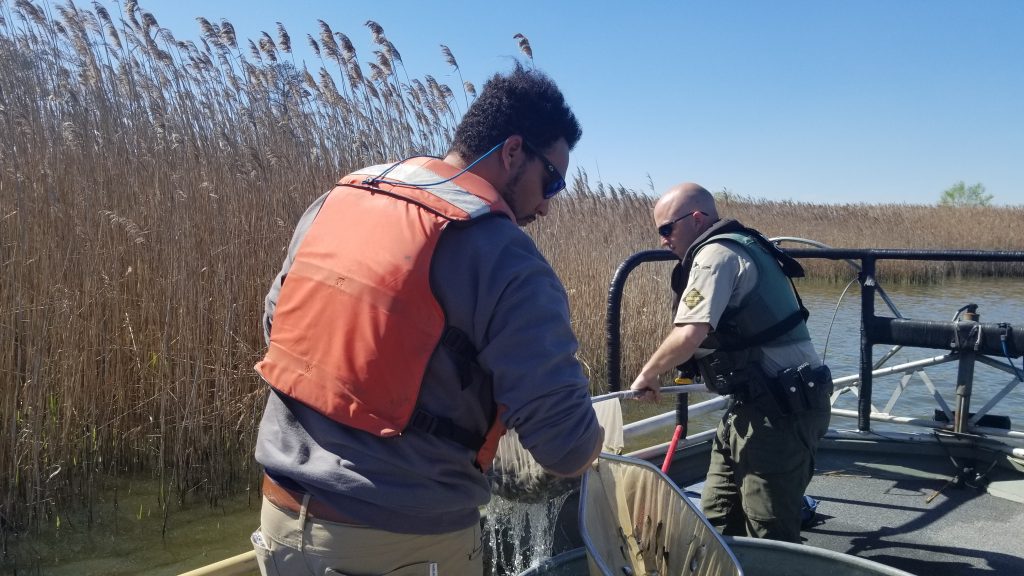
NCWRC biologist Deon Kerr and Wildlife Enforcement Officer Stephen Pearce stocking Bluegill into Common Carp spawning habitat.
Submitted by Kevin Dockendorf, NC Wildlife Resources Commission
Spotlight on Students and Young Professionals
Danci was born and raised in central Oklahoma. She received her B.S. in Zoology and Fisheries/Aquatic Ecology at Oklahoma State University (2018) and served as president of the student subunit during 2016-2017. Danci was a fisheries technician for Kansas Department of Wildlife and Parks from 2018-2021 and a fisheries biologist for Kentucky Department of Fish and Wildlife Resources from 2022-2023. She studied crappie Pomoxis spp. exploitation in southeast Kansas for her M.S. in Biology from Missouri State University (2022). Danci joined the NC Wildlife Resources Commission as District 5 Fisheries Biologist I in January 2023. She and her husband, Jacob, live in Gibsonville with their 3 dogs.
Deon is originally from Ohio and earned his undergraduate degree from Bowling Green State University where he graduated Cum Laude in Aquatic Biology with a Minor in Environmental Sciences. Deon went on to earn an M.S. from Clemson University under Dr. Troy Farmer. The title of this thesis is “Evaluating movement and habitat selection patterns by Largemouth Bass Micropterus salmoides and Alabama Bass M. henshalli on Lake Hartwell, South Carolina.” Deon has also been a technician for the Ohio Division of Wildlife and is active in American Fisheries Society. Deon Kerr started January 3, 2023, as the District 1 Fisheries Biologist I for the NC Wildlife Resources Commission. Deon is an avid hunter and carp angler in his free time. He has moved to Elizabeth City and has already been hard at work stocking Bluegill and surveying anadromous fish.
Nick Shaver rejoined the NC Wildlife Resources Commission’s Inland Fisheries Division in June 2022 as the District 2 Fisheries Biologist I. Nick started his career working as creel clerk for a FERC relicensing project in Jackson County, NC in 2000. Soon after he moved to McKinney Lake State Fish Hatchery where he propagated and stocked Channel Catfish Ictalurus punctatus for the Community Fishing Program. In 2003, Nick transferred to the “Fisheries Development Crew” in District 6 where he constructed public fishing areas, provided public outreach programs such as “Fish for Fun” and the Mobile Aquarium, and assisted biologists across the Piedmont and Coastal regions with various sampling efforts from early Robust Redhorse Moxostoma robustum work on the Pee Dee River to Roanoke Bass Ambloplites cavifrons electrofishing in the rocky streams of the upper Piedmont. In 2008, he transferred to the District 8 Fisheries Development Crew where he assisted with trout, Smallmouth Bass M. dolomieu, Walleye Sander vitreus, Muskellunge Esox masquinongy and many other cool and warmwater species surveys across the region. After the NCWRC’s agency reorganization, Nick moved on to become the Northern Mountains Technician Supervisor where he led 4 crews in the agency’s management of Game Lands, Public Fishing Areas and Boating Access Areas in Districts 7 and 8. Nick left this role to become the NCWRC’s first dedicated Angler R3 specialist where he was involved in angler recruitment, retention and reactivation efforts across North Carolina. In 2020, Nick was promoted to the Land and Water Access Division’s Mountain Region Supervisor where some of his work included spearheading land acquisition projects for public access and conservation of species and critical aquatic and terrestrial habitats in Western North Carolina. In his free time Nick is an avid angler and is enjoying learning the challenges of inshore fishing around Pamlico Sound. He is a new resident of Swan Quarter and proud “cheer dad” of a Mattamuskeet Laker named Maggie and has been married to Dr. Melanie Shaver for 20 years. He is working with TD VanMiddlesworth (D2 Fisheries Biologist) to tackle the challenges of our coastal river fisheries and to make fishing better in District 2.
Submitted by Seth Mycko, Ben Ricks, and TD VanMiddlesworth, NC Wildlife Resources Commission
Updates from the East Carolina University Student Subunit
Greetings from the East Carolina University Student (ECU) Subunit of the American Fisheries Society. This spring we would like to share some of the exciting research that our members are working on here at ECU. We would also like to congratulate all of our members who are graduating this spring. We know that you all will do great things in your future work, and we wish you the best in your future endeavors! Go Pirates!
ECU Pirates in the Field
Reece Warfel
M.S Student Asch Lab
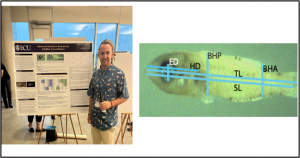
Reece Warfel (l) giving a poster presentation at a recent AFS conference. An example of some morphometric measurements taken on a juvenile fish sample (r).
While larval abundance has been surveyed in the past three decades in Beaufort, NC, variations in larval abundance have not been consistently related to recruitment for many fish species, including larval Mojarra, Broad-striped Anchovy Anchoa hepsetus, White Mullet Mugil curema, and Atlantic Croaker Micropogonias undulatus. By studying how environmental factors affect the morphometric condition of fish larvae, we may be able to better anticipate when a high or low recruitment year occurs since condition affects fish growth and survival. This project aims to understand the relationship between morphometric condition in comparison with environmental variables (e.g., temperature, mesozooplankton volume) among larvae collected during 2017–2019 to determine if there is interannual variation in how oceanic conditions affect these fishes. I hypothesized that when zooplankton is abundant, there will be better morphometric condition of larval fishes. I also tested if morphometric condition of larvae will decrease due to stress caused by summer temperatures. Lastly, I examined if larval body condition reacts consistently to these environmental variables across multiple years. Results from this experiment shows that the interaction of zooplankton and temperature along with larval density are the most influential variables. Further collection of morphometric condition will help uncover more patterns and increase the ability to incorporate body condition into future recruitment models.
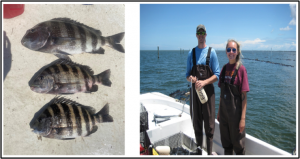
Sheepshead samples taken from Pamlico Sound (l). Morley Lab members Andrew McMains and Maddie Johnson (r) setting traps for Sheepshead.
Maddie Johnson
M.S Student, Morley Lab
I am researching juvenile Sheepshead Archosargus probatocephalus in Pamlico Sound, North Carolina, focusing on hatch dates, growth rates, habitat preferences, and distributions within the estuary. Sheepshead are an important fish species in North Carolina, promoting a large targeted recreational fishery. There is currently no state or federal fishery management plan for Sheepshead, and resource managers have expressed the need for more research on their life history. My research will provide important early life history information on Sheepshead that can be used to inform future management actions for the species. Additionally, my research will contribute to the collaborative study of Sheepshead in North Carolina and quantify the importance of key habitat areas for multiple species within the estuary.
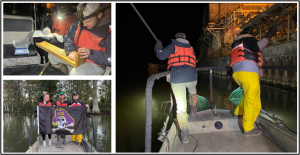
Clockwise from bottom left: Field Lab members representing ECU before a night of sampling on the Roanoke River. Lab members Chase Spicer and Cammy Bailey measure Blueback Herring. Chase Spicer and ECU Water Resources member Will Langley netting fish on the lower Roanoke River.
Chase Spicer
M.S Student, Field Lab
I am researching river herring in Lower Roanoke River, North Carolina, using environmental DNA (eDNA). In North Carolina watersheds, river herring were once highly sought after by commercial and recreational fisheries. Herring once supported one of the largest freshwater commercial fisheries in the world, but in the mid-to-late 20th-century populations experienced sharp declines and have since shown little recovery. A technique to accurately monitor river herring spawning populations and juveniles both quickly and non-invasively would greatly assist in assessing the impact of population recovery efforts while monitoring fish movements. In my research I am studying eDNA from two species of river herring, Blueback Herring Alosa aestivalis and Alewife A. pseudoharengus and quantifying samples using a real-time polymerase chain reaction. Lab members and I have been taking weekly water samples along the Lower Roanoke River and its tributaries from February through November since spring 2021. In partnership with Army Corps of Engineers, The Nature Conservancy, and The Sustainable Rivers Program, data will be used to better our understanding of the effects of water flows on adult river herring and juvenile movement within the Lower Roanoke River basin. This past fall and this spring we are working to validate peaks in eDNA counts using traditional biological sampling techniques such as boat electrofishing.
Submitted by Chase Spicer, ECU Student Subunit President
Good Work! – Recent Publications by NCAFS Members
Alley, Z., F. Rohde, E.J. Burge, W.R. Burge, W. R. Burge, and B. Albanese. 2022. Distribution of the Bluefin Killifish, Lucania goodei, in Georgia and the Carolinas. American Currents 47 (3):1-7.
Dorsey, L.G., and M.A. Abney. 2022. Changes in black bass population characteristics after the introduction of Alabama Bass in Lake Norman, North Carolina. Journal of the Southeastern Association of Fish and Wildlife Agencies 3:161-166.
Ceriaco, L. M., et al. 2023. Renaming taxa on ethical grounds threatens nomenclatural stability and scientific communication. Zoological Journal of the Linnean Society.
Goodfred, D.W., C.J. Wood, and J.M. Rash. 2023. Effects of introduced Alabama Bass on an existing Largemouth Bass fishery in Moss Lake. Journal of the Southeastern Association of Fish and Wildlife Agencies 10:68-75.
Rash, J., and L. Etchison. 2023. Hey, that’s not a trout! Wildlife in North Carolina 87(2):39-43.
Rudershausen, P., F. Cross, B. Runde, D. Evans, W. Cope, and J. Buckel. 2023. Total mercury, methylmercury, and selenium concentrations in blue marlin Makaira nigricans from a long-term dataset in the western north Atlantic. Science of the Total Environment DOI 10.1016/j.scitotenv.2022.159947
Sammons, S.M, L.G. Dorsey, C.S. Loftis, P. Chrisman, M. Scott, J. Hammonds, M. Jolley, H. Hatcher, John Odenkirk, J. Damer, M.R. Lewis, and E.J. Peatman. 2023. Alabama Bass Alter Reservoir Black Bass Species Assemblages When Introduced Outside Their Native Range. North American Journal of fisheries Management 0:1-16.
Submitted by the NCAFS Newsletter Review Team
Stories of Interest
Snorkeling the mountains
Luke Etchison discusses a venture partially funded by NCAFS
Meet your biologist
Casey Joubert talks Alabama Bass and the dangers of moving fish around
Alabama Bass invasion
Lawrence Dorsey and Scott Loftis also talk about impacts from Alabama Bass
River in rebound
Luke Etchison and Powell Wheeler discuss potential biodiversity impacts from mill closing
Native fish returned to French Broad River
Luke Etchison talks to locals about restoring species in Transylvania County
Fish a significant source of PFAS exposure
Fallout from widespread PFAS use continues
Bedouin fisherwomen swim against a male tide
Hardship in small-scale fisheries in Oman
Alaska’s fisheries are collapsing
Alaska representative Mary Peltola takes on the trawl industry
The fight of the Salmon People
Native families fight for their right to fish
Salmon fisheries closed in California and Oregon
Bad news out west
Submitted by the NCAFS Newsletter Review Team
Call to Action!
If you want to contribute, have a story idea or would like us to include something in next quarter’s newsletter, email Kyle Rachels at [email protected] or give him a call at 252-548-4938.
Also, if you want to become more involved with one of the many great NCAFS committees then please check this link for information about each one, contacts, etc., https://nc.fisheries.org/who-we-are/committees/
 Valuable Links
Valuable Links
The American Fisheries Society Home Page offers a wealth of links to assist you in your fishy endeavors. This and archived NCAFS newsletters, along with links, chapter information, and upcoming meetings, can be found here on our own website.

